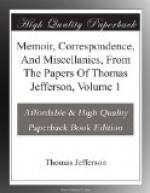Turning to your Encyclopedie, Arts et Metiers, tome 3, part 1, page 393, you will find mentioned an instrument, invented by a Monsieur Renaudin, for determining the true time of the musical movements, largo, adagio, &c. I went to see it. He showed me his first invention; the price of the machine was twenty-five guineas: then his second, which he had been able to make for about half that sum. Both of these had a mainspring and a balance-wheel, for their mover and regulator. The strokes are made by a small hammer. He then showed me his last, which is moved by a weight and regulated by a pendulum, and which cost only-two guineas and a half. It presents, in front, a dial-plate like that of a clock, on which are arranged, in a circle, the words largo, adagio, andante, allegro, presto. The circle is moreover divided into fifty-two equal degrees. Largo is at 1, adagio at 11, andante at 22, allegro at 36, and presto at 46. Turning the index to any one of these, the pendulum (which is a string, with a ball hanging to it) shortens or lengthens, so that one of its vibrations gives you a crochet for that movement. This instrument has been examined by the academy of music here, who were so well satisfied of its utility, that they have ordered all music which shall be printed here, in future, to have the movements numbered in correspondence with this plexi-chronometer. I need not tell you that the numbers between two movements, as between 22 and 36, give the quicker or slower degrees of the movements, such as the quick andante, or moderate allegro. The instrument is useful, but still it may be greatly simplified. I got him to make me one, and having fixed a pendulum vibrating seconds, I tried by that the vibrations of his pendulum, according to the several movements. I find the pendulum regulated to Largo
[Illustration: The Plexi-Chronometer, page391]
Every one, therefore, may make a chronometer adapted to his instrument.
For a harpsichord, the following occurs to me:
In the wall of your chamber, over the instrument, drive five little brads, as, 1, 2, 3, 4, 5, in the following manner. Take a string with a bob to it, of such length, as, that hung on No. 1, it shall vibrate fifty-two times in a minute. Then proceed by trial to drive No. 2, at such a distance, that drawing the loop of the string to that, the part remaining between 1 and the bob, shall vibrate sixty times in a minute. Fix the third for seventy vibrations, &c.; the cord always hanging over No. 1, as the centre of vibration. A person playing on the violin may fix this on his music-stand. A pendulum thrown into vibration will continue in motion long enough to give you the time of your piece. I have been thus particular, on the supposition that you would fix one of these simple things for yourself.




